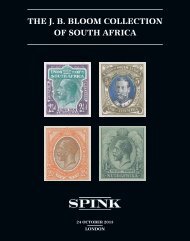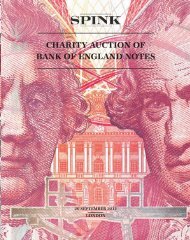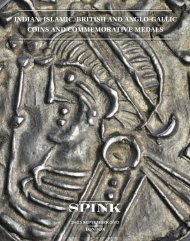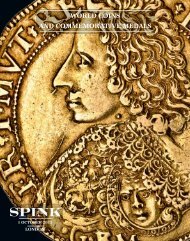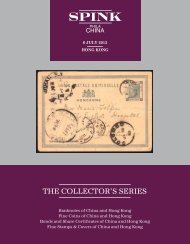Download PDF - Spink
Download PDF - Spink
Download PDF - Spink
- No tags were found...
Create successful ePaper yourself
Turn your PDF publications into a flip-book with our unique Google optimized e-Paper software.
Dec 05 Editorial 29/11/05 4:27 pm Page 374secondary mint, wherever that might have been, otherwise itshould have contained a few coins of the last issue of thesecondary mint unless, of course, the two issues of the secondarymint were contemporary with the first two issues of the mainmint and the secondary mint had closed before the end of Isaac’sreign after which the only coins commonly available wouldpossibly only have been billon trachea of the first issue 30 and thetrachea and tetartera of the third issue of the main mint whichmight account for the fact that there was only a single coin of thefirst issue of the secondary mint and no coins of the second issueof the main mint in the hoard since all coins of Isaac except forDO 2 are very rare.The writer would like to thank Dr. D. M. Metcalf, Dr. W. Schultze,Dr. I. Touratsoglou, Ms. Yorka Nicolaou and Mr. T. Eden for theirhelp. The suggestions put forward here are entirely those of thewriter.Footnotes:1. ‘A Cypriot Coin of Richard Lion-heart’, NCirc., April 2002, vol. CX, no. 2.2. It is possible that this coin is in the Nicosia Museum.3. A correspondent has recently told the writer that he was shown twospecimens of this type in Larnaca which seems to indicate the existanceof at least four specimens of this type.4. “A New Type of Electrum Trachy of Isaac Comnenus of Cyprus (AD1184-1191)’, NCirc. May 1989, vol. XCVII, no.4. The writer hadproduced a more ‘popular’ version of this article entitled ‘IsaacComnenus: just a little empire on Cyprus’ in the Celator, vol. 3, no. 2,February 1989 and at that time he obviously did not know of the hoarddiscussed in addendum II. All coins illustrated in the NCirc article withexception of no. 1 were in the writer’s collection and, with the exceptioneither no. 3 or 6, were stolen in Los Angeles in late 1989. If any reappearon the market the writer would like to be informed.5. M. F. Hendy, ‘Coinage and Money in the Byzantine Empire, 1081-1261’,Dumbarton Oaks Studies XII, Washington 1969, pp. 136-142. Hendyalso listed a trachy (DO 5) and a tetarteron (DO 10) as ‘uncertainattribution’ (pl. 21, nos. 12-14.).6. M.F. Hendy, ‘Catalogue of the Byzantine Coins in Dumbarton OaksCollection and in the Whittemore Collection’, vol. IV, Washington 1999,pp. 354-364.7. There appears to be some evidence that those coins of Heraclius depictingthree standing figure with a Cyprus mint mark may not have been struckin Cyprus since none seem to have been found on the island. P. Pavlougave a paper (unpublished) to the Oriental Numismatic Society severalyears ago which touched upon this matter. In addition, when Cypriotcollectors come to London they tend to buy all the three standing figureCyprus folles they can find which might confirm that these coins are notfound in the island, although since writing this, I now understand theyare.8. In the catalogue and plates in DOC IV these two issues are in the wrongorder since these parts of the catalogue had been completed some yearsbefore the writer published these overstrikes in 1989 (see footnote 4). Inhis late completion of the catalogue Hendy did note this overstrike in thetext.(DOC IV, vol. I, p. 357).9. ‘The Kingdom of Cyprus and the Crusades, 1191-1374’, Peter W.Edbury, CUP 1991. The first two chapters touch upon the backgroundand earliest years of Lusignan rule.10. Edbury, op. cit., p.29.11. G. Jeffery, ‘Cyprus under an English King in the Twelfth Century’, CyprusGovernment printer, 1926.12. ‘Oxford Dictionary of Byzantium’, vol. I, OUP 1991, p.567.13. D.M. Metcalf, ‘Byzantine Lead Seals from Cyprus’, Cyprus ResearchCentre, Texts and Studies of the History of Cyprus XLVII, Nicosia 2004,p. 37.14. ‘Byzantine Mediaeval Cyprus’, Bank of Cyprus Cultural Foundation,Nicosia, 1998.15. D. M. Metcalf, ‘The White Bezants and Deniers of Cyprus 1192 - 1285’,Texts and Studies of the History of Cyprus XXX, Cyprus Reseach Centre,Nicosia 1998, pp. 11 - 13.16. Edbury, op. cit., pp. 8 and 13.17. The writer acquired the two electrum trachea that he published in 1989in August 1988 from an American Armenian dealer who made frequenttrips to Istanbul. The specimen sold through Baldwins in 1995 wasbought in 1989 in a German auction (often a sign of a Turkish source)while the two most recent electrum trachea, one of each type, sold in theGemini I auction (see footnote 21) also came from a Turkish dealer inMunich.Perhaps we should consider the provenance of the first threespecimens of the first type of electrum trachy (DO 1). The specimen in theBibliotheque in Paris came from the Lambros collection and was acquiredin Cyprus. The pierced specimen in the Goodacre collection (Christiesauction, 24 April 1986, lot 324), was bought by Goodacre from Seaby’s17. in 1942 for 15/- (75 p) and is now in DO. The third specimen, from theWhitting collection, is in Barber Institute in Birmingham. Whittingpurchased it from Baldwins on 23 April 1969. It must have been sold tohim by the writer who has no recollection of doing so and possibly misidentifiedit. The writer may have purchased it at the time or found in oldstock. Since Goodacre bought most of his coins in London it seems likelythat both his and Whittings specimens of DO 1 came from Cyprus whichwas ruled by the British at that time - but did these these coins come fromwhat is now Turkish occupied northern Cyprus?18. M. F. Hendy, ‘Studies in the Byzantine Economy, c. 300-1450, CUP 1985,pl.31, no.13 (unmentioned in the text) and catalogued but not illustratedas DOC IV (8 bis).This coin belonged to the late John J. Slocum of Newport, RhodeIsland, whose coins of Isaac of Cyprus were sold through Sothebys inauction LO 9447 of 14th Oct. 1999, lots 179-186 although this uniquetetarteron was missing. Only its ticket arrived with the collection whichindicated that it had been purchased from <strong>Spink</strong> and Son. It was onlywhen Sothebys received the collection from Slocum’s heirs that it wasdiscovered that a number of coins had been stolen by a domestic servant.The writer thinks it unlikely that Hendy and Slocum were in contact andit may be that the reason that the writer ‘mislaid’ his photograph of thecoin and was unable to illustrate it in either of his 1989 articles whileHendy was able to illustrate it in 1985 was because the writer had sentthe photograph to Hendy by 1985. In the 1970’s and 1980’s the writersent photographs of most of his ‘discoveries’ to Hendy. About 40 coinsillustrated in DOC IV belonged to the writer and are now in theAshmolean Museum. That this particular coin is not illustrated in DOC IVis because the plates were in proof by c. 1980 and any new coinsdiscovered after that date could not be illustrated.19. Hendy suggested that Isaac did not begin to strike coins until he hadrepulsed Isaac II’s attempt to recapture Cyprus in 1187 and that he hadceased issuing coins even before the arrival of Richard I (DOC IV, p. 357).It seems unlikely that so many different types would have been struck inonly four years but if this was the case then Isaac preceded the post-1204Byzantine emperors in changing the design of his coinage annually.20. Four electrum trachea, possibly only four billon trachea and possibly adozen tetartera although it seems possible that more trachea andtetartera from the hoard noted in addendum II might exist in Cypriotcollections. A specimen of DO 8 fetched $1420 as lot 1355 in the wintermail bid sale of NFA of 14 December 1989. This coin is unlikely to havecome from the hoard listed in addendum II and its extremely high pricereflected its rarity at that time when it was obviously considered unique.21. Isaac does not appear personally on his imperial seals which depict St.Theodore (Metcalf, op. cit. pp. 338-339). What significance St. Georgehad for Isaac is uncertain although the saint also appears on thecommonest and apparently earliest of Isaac’s billon trachea (DO 2).22. Two other specimens have appeared in auctions - A.H.Baldwin auction 5,11 Oct. 1995, lot 273 (acquired from a German auction in 1989) andGemini I, 11-12 Jan 2005, lot 516. Gemini was a joint auction ofFreeman and Sear and Harlan J. Berk held at the New York NumismaticConvention. Lot 515 of the Gemini I sale was a specimen of DO 1, bothcoins coming from Turkey.23. ‘Two Rare Byzantine Coins of the Comnenian Dynasty’, NCirc., vol CIX,no. 5, Oct. 2001, no. 2.24. Just as he had completed this article the writer received a photo of yetanother tetarteron which is illustrated as fig. 5 by kind permission of theowner. This coin (illustrated c. x 1.5 actual size) is the same as DO 7except that Christ appears not as a bust but as a half-length figure withright hand raised in benediction and holding the Gospels. Hendy wasunable to tell what Isaac was holding in his left hand from the specimenhe illustrated in DOC IV but other coins indicate that he holds an akakia.It is difficult to tell whether this new coin is merely a variant of DO 7struck from a single die where the engraver had mistaken hisinstructions. A second specimen might solve the problem. If anotherspecimen is struck from different dies or if Isaac holds a globus instead ofan akakia this type must be a separate issue. Although Isaac’s title is notvisible, the fact that the the emperor has looped pendilia should indicatethat this too is an issue of the primary mint.25. These analyses were carried out at Durham University but unfortunatelythe equipment was so new that it not been calibrated and it was notpossible to give exact figures except to say that there were similar smallamounts of silver in both the trachea and tetartera.26. The writer noted that seven specimens of DOC 2 had retrograde legendsand pendilia with single drops. This information certainly came from thewriter’s first informant, since these were features the writer failed to notewhen he acquired the hoard. However, when this article was almostcomplete, the writer found that he still had two trachea of DO 2 and onetetarteron of DO 8 left from the hoard. One of the trachea seems to be oneof these retrograde coins referred to. Both pendilia end in single pellets,the left hand one possibly having a side loop and the right hand one plain.Isaac’s name is not visible but, on the right, the name of St. George isengraved in retrograde letters. The note of a retrograde legend seems torefer only to the letters and does not mean that the names weretransposed.374 NUMISMATIC CIRCULAR



